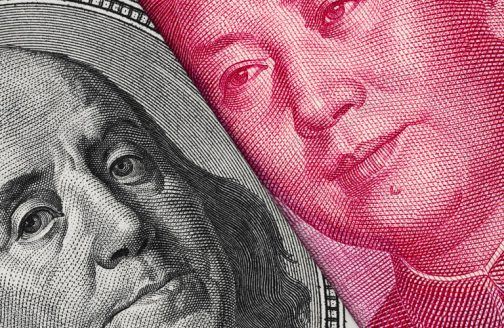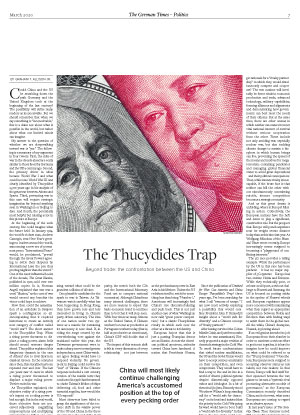Beyond trade: the confrontation between the US and China

Could China and the US be stumbling down the path Germany and the United Kingdom took at the beginning of the last century? The possibility will strike many readers as inconceivable. But we should remember that when we say something is “inconceivable,” this is a claim not about what is possible in the world, but rather about what our limited minds can imagine.
My answer to the question of whether we are sleepwalking toward war is “yes.” The following is a summary of my argument in four tweets: First, the risks of war in the decade ahead are eerily similar to those faced by Germany and the UK a century ago. Second, the primary driver in what became World War I and what could become World War III was clearly identified by Thucydides 2,500 years ago in his analysis of the great war between Athens and Sparta. Third, preventing war in this case will require strategic imagination far beyond anything seen in Washington or Beijing to date. And fourth, the potentially most helpful but missing actor in this picture is Europe.
At the beginning of the 20th century, few could imagine what the future held. In January 1914, the world’s richest man, Andrew Carnegie, sent New Year’s greetings to leaders around the world, announcing a new era of permanent peace. “International Peace” would, he proclaimed, “prevail through the Great Powers agreeing to settle their disputes by International Law, the pen thus proving mightier than the sword.” One of the most influential books of the decade, The Great Illusion, published in 1910, sold over two million copies. In it, Norman Angell explained that war was a cruel “illusion,” as the cost of war would exceed any benefits the victor could hope to achieve.
How then could the assassination of an archduke in Sarajevo spark a conflagration so all-encompassing that it required historians to create an entirely new category of conflict called “world war”? The short answer is: the Thucydides Trap. When a rising power threatens to displace a ruling power, alarm bells should sound: extreme danger ahead. Thucydides explained this dangerous dynamic in the case of Athens’ rise to rival Sparta in classical Greece. In the centuries since then, this storyline has been repeated over and over. The last 500 years saw 16 cases in which a rising power threatened to displace a major ruling power. Twelve ended in war.
As Thucydides explained, the objective reality of a rising power’s impact on a ruling power is bad enough. But in the real world, these objective facts are perceived subjectively – magnifying misperceptions and multiplying miscalculations. When one competitor “knows” what the other’s “real motive” is, every action is interpreted in ways that confirm that bias.
Under such conditions, the competitors become hostage to third-party provocations and even accidents. An event as bizarre and otherwise inconsequential as the assassination of an archduke forces one or the other principal protagonist to respond. Doing so triggers a vicious spiral of actions and reactions that drag both toward an outcome neither wanted.
If Thucydides were watching today, he would say that China and the US are right on script, competing to show which can best exemplify the role of the rising and ruling power, accelerating toward what could be the grandest collision of all time.
One plausible candidate for the spark to war is Taiwan. As Taiwanese watch carefully what has been happening in Hong Kong, they have grown less and less interested in living in China’s party-driven autocracy. The idea of one nation under two systems as a mantle for sustaining its autonomy is now dead. If, in riding the surge created by the overwhelming vote against the mainland earlier this year, the Taiwanese government were to make a sharp move toward greater independence, most China watchers agree Beijing would have to respond violently. No government in Beijing could survive the “loss” of Taiwan. If the Chinese response included a 21st-century version of the missile tests they conducted in 1996 that threatened to choke Taiwan’s lifeline of ships delivering oil, food and other essential supplies, how would the US respond?
Most observers have failed to grasp the significance of the tectonic shift in the relative power of the US and China in the three decades since the end of the Cold War. Never before in history has a rising power ascended so far, so fast and in so many different dimensions. To paraphrase former Czech President Václav Havel, things have happened so fast that we have not yet had time to be astonished.
The US share of global GDP has fallen from almost one-half in 1950, to one-quarter at the end of the Cold War in 1991, to one-seventh today. (Although GDP is not everything, it does form the substructure of power in relations among nations.) In 1991, China barely appeared on any international league table. But in the past generation, its GDP has soared: from 20 percent of the US level in 1991 to 120 percent today (as measured by purchasing power parity, the metric both the CIA and the International Monetary Fund use to compare national economies). Although China faces many internal challenges, there are more reasons to expect this basic economic trend to continue than to bet that it will stop soon. With four times as many citizens as the United States, if Chinese workers become as productive as Portuguese workers today (that is, half as productive as Americans), China’s GDP will double that of the US.
The impact of this tectonic shift is felt in every dimension of every relationship – not just between the US and China, but between each of them and other nations. In Asia, the economic balance of power has tilted especially dramatically in China’s favor. As the world’s largest exporter and second-largest importer, China is the top trading partner of every other major Asian country, including US allies. And as an aggressive practitioner of economic statecraft, Beijing does not hesitate to use the leverage this provides, squeezing countries such as the Philippines and South Korea when they resist Chinese demands. A similar story is emerging in Europe.
China will most likely continue challenging America’s accustomed position at the top of every pecking order. If Xi succeeds, China will displace the US as the predominant power in East Asia in his lifetime. Unless the US redefines itself to settle for something less than being “Number 1,” Americans will increasingly find China’s rise discombobulating and push back. This is not just another case of what Washington now calls “great-power competition,” but a classic Thucydidean rivalry in which each sees the other as a threat to its identity.
European hopes that this is just a passing Trumpian detour are an illusion. Across the American political spectrum, attitudes toward China have hardened. A nation that Presidents Obama, Bush and Clinton called its “strategic partner” is now seen by all as a “strategic adversary.” Instructively, Democratic candidates for president are scrambling to find a way to get to the right of Trump on China.
Does this mean that war – real bloody war – is inevitable? No, most certainly not. Four of the sixteen cases in the Thucydides Trap case file ended without war. Nonetheless, if American and Chinese leaders settle for statecraft as usual, we should expect history as usual. The goal in recognizing how devastating that war would be, and understanding how such rivalries have so often ended in catastrophe, is to motivate strategists and statesmen to rise above history.
Since the publication of Destined for War: Can America and China Escape Thucydides’s Trap? three years ago, I’ve been searching for what I call “avenues of escape.” I am now most actively exploring a possibility that would combine President John F. Kennedy’s insight about a “world safe for diversity” and a Chinese concept of “rivalry partners.”
After having survived the Cuban Missile Crisis, and just five months before he was assassinated, Kennedy proposed a major revision of America’s strategy in the Cold War. To avoid future confrontations that risked nuclear annihilation, the US and the Soviet Union would have to accept serious constraints on their competition, and even compromise. They would have to find a way to live and let live in a world of diverse political systems despite diametrically opposed values and ideologies. In a bit of rhetorical jiu-jitsu, Kennedy stood Woodrow Wilson’s long-standing call for a “world safe for democracy” on its head and insisted that the priority in the Cold War going forward would have to be to build a “world safe for diversity.” In that future, the two rivals could compete vigorously – yet peacefully – to demonstrate whose values and system of governance could best meet the needs of its citizens.
A millennium earlier, the Song emperor, having found his troops unable to defeat a northern Mongolian tribe, the Liao, negotiated the Treaty of Chanyuan that established a “rivalry partnership.” The two parties agreed to compete ruthlessly in some arenas and cooperate intensely in others. In an unusual version of Chinese tributary relations, the treaty required the Song to pay tribute to the Liao, who in turn agreed to invest that payment in economic, scientific and technical development in Song China.
Could American and Chinese statesmen construct a new strategic rationale for a “rivalry partnership” in which they would simultaneously compete and cooperate? The two nations will inevitably be fierce rivals in economic production and trade, advanced technology, military capabilities, forming alliances and alignments and demonstrating how governments can best meet the needs of their citizens. But at the same time, there are other arenas in which neither can ensure its most vital national interest of survival without serious cooperation from the other. These include not only avoiding war, especially nuclear war, but also tackling climate change to sustain a biosphere in which human beings can live, preventing the spread of the means and motives for mega-terrorism, containing pandemics and managing global financial crises to avoid great depressions – and their political consequences. Thus, while intense rivalry is inescapable, if the brute fact is that neither can kill the other without simultaneously committing suicide, intense competition becomes a strategic necessity.
And as this great drama is unfolding, where is Europe? Missing in action. Collectively, the European nations have the heft and sense to play a significant, constructive role. But the prospect that Europe will punch anywhere near its weight seems dimmer today than at this time last year. As Wolfgang Münchau of the Financial Times wrote recently, Europe increasingly seems resigned to becoming a “playground of conflicting interests.”
The 5G race provides a telling example. While the performance by the US in this race has been pathetic – it has no major supplier of 5G systems – Europe has two entries: Nokia and Ericsson. While they technically pose, or at least could pose, a serious challenge to Huawei and Samsung, the US is focused on putting sticks in the spokes of Huawei wheels and European regulators appear more concerned with maintaining what they regard as appropriate competition between Nokia and Ericsson than with finding ways to assist them in the global race. All the while, China’s champion, Huawei, is plowing ahead.
If an evil genius intended to jolt Europeans from their slumber in order to motivate a serious effort to get its act together, it is hard to imagine how he could improve on what could be referred to as the “Trump treatment.” Nonetheless, Europeans seem resigned to accepting observer status as rule takers, not rule makers. In that future, Europe will find itself further squeezed between the two giants: to its east, a “systemic rival promoting alternative models of governance,” as the European Commission recently described China, and to its west, what some Europeans are coming to regard as an abusive spouse.
In last year’s issue of The Security Times, Theo Sommer noted: “The geopolitical rivalry between the US and the People’s Republic of China is not going to end. It will be the dominant element of international politics in the 21st century.” The question this year is whether Europe must remain, in Sommer’s words, “a helpless and clueless bystander.” As we watch the US and China stumble toward a dangerous collision, anyone who cares about international peace and security must fervently hope not.
Graham T. Allison Jr.
is a professor at the John F. Kennedy School of Government at Harvard. In 2017, he published Destined for War: Can America and China Escape Thucydides’s Trap?



